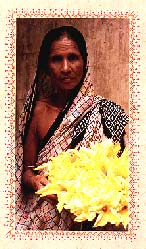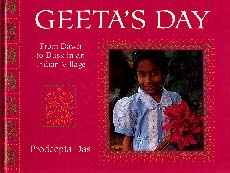|
________________
CM . . . .
Volume VII Number 3 . . . . October 6, 2000
excerpt: At lunch time, Geeta and her friends share out the pickles and relishes they have brought with them. Free school meals were started recently to encourage children from poorer families to come to school.  Geeta is a six-year-old girl who lives with her parents, three brothers and older sister in a small
village, Janla, which is located in the state of Orissa in eastern India. Via text and full colour
photographs, Das, a freelance photographer and author of more than 20 children's books, takes
readers through a "typical" day in the young girl's life, a day which begins at dawn with prayers
and a bucket bath, and which ends, after supper, with a story from a religious epic before bed. In
between, Geeta attends school, plays games, swims in the village pond, and buys items from door-
to-door pedlars. By paying careful attention to the text, Western readers can note the similarities
and differences between their lives and that of Geeta. While, for example, three meals a day are
common to both cultures, readers will likely find quite a difference between Geeta's menu and
their own. Each pair of facing pages contains from two to four photos which are captioned. In
most instances, the photos are of something mentioned in the pages' main text, and the captions
develop the term in more detail. For example, the principal text mentions that Geeta's favourite
school game is PUCHI, and one of the two photographs on that page shows girls playing the
game while the caption briefly explains how the game is played. Careful examination of the
photographs will also provide information which is not provided in the text. Readers could, for
instance, note the paucity of furniture and people eating food with their hands rather than with
utensils. In the main, the photos have a candid appearance though a few, such as that of the
children brushing their teeth "with a special twig taken from the nearby neem tree" or Geeta
swinging on a rope swing, look posed.
Geeta is a six-year-old girl who lives with her parents, three brothers and older sister in a small
village, Janla, which is located in the state of Orissa in eastern India. Via text and full colour
photographs, Das, a freelance photographer and author of more than 20 children's books, takes
readers through a "typical" day in the young girl's life, a day which begins at dawn with prayers
and a bucket bath, and which ends, after supper, with a story from a religious epic before bed. In
between, Geeta attends school, plays games, swims in the village pond, and buys items from door-
to-door pedlars. By paying careful attention to the text, Western readers can note the similarities
and differences between their lives and that of Geeta. While, for example, three meals a day are
common to both cultures, readers will likely find quite a difference between Geeta's menu and
their own. Each pair of facing pages contains from two to four photos which are captioned. In
most instances, the photos are of something mentioned in the pages' main text, and the captions
develop the term in more detail. For example, the principal text mentions that Geeta's favourite
school game is PUCHI, and one of the two photographs on that page shows girls playing the
game while the caption briefly explains how the game is played. Careful examination of the
photographs will also provide information which is not provided in the text. Readers could, for
instance, note the paucity of furniture and people eating food with their hands rather than with
utensils. In the main, the photos have a candid appearance though a few, such as that of the
children brushing their teeth "with a special twig taken from the nearby neem tree" or Geeta
swinging on a rope swing, look posed.
Particularly because it offers a child's eye view of one aspect of the Indian culture, Geeta's Day will be a useful addition to those schools which conduct comparative culture studies. Recommended. Dave Jenkinson teaches courses in children's and adolescent literature in the Faculty of Education, University of Manitoba.
To comment on this title or this review, send mail to cm@umanitoba.ca.
Copyright © the Manitoba Library Association.
Reproduction for personal use is permitted only if this copyright notice
is maintained. Any other reproduction is prohibited without
permission.
Published by
TABLE OF CONTENTS FOR THIS ISSUE - October 6, 2000.
AUTHORS |
TITLES |
MEDIA REVIEWS |
PROFILES |
BACK ISSUES |
SEARCH |
ORDER |
CMARCHIVE |
HOME
|
